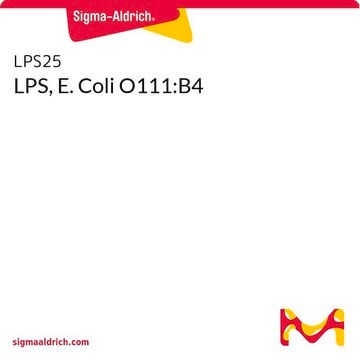Products may be shipped at a different temperature than the recommended long-term storage temperature. If the product quality is sensitive to short-term exposure to conditions other than the recommended long-term storage, it will be shipped on wet or dry-ice. If the product quality is NOT affected by short-term exposure to conditions other than the recommended long-term storage, it will be shipped at ambient temperature. As shipping routes are configured for minimum transit times, shipping at ambient temperature helps control shipping costs for our customers. For more information, please refer to the Storage and Transport Conditions document: https://www.sigmaaldrich.com/deepweb/assets/sigmaaldrich/marketing/global/documents/316/622/storage-transport-conditions-mk.pdf
L4516
Lipopolysaccharides from Escherichia coli O127:B8
BioXtra, suitable for cell culture, γ-irradiated
Synonyme(s) :
LPS
Sélectionner une taille de conditionnement
Sélectionner une taille de conditionnement
About This Item
Produits recommandés
Source biologique
Escherichia coli (O127:B8)
Niveau de qualité
Stérilité
γ-irradiated
Gamme de produits
BioXtra
Forme
lyophilized powder
Produit purifié par
gel-filtration chromatography
Technique(s)
cell culture | mammalian: suitable
Impuretés
<1% Protein (Lowry)
Solubilité
H2O: 5 mg/mL, slightly hazy
Température de stockage
2-8°C
Vous recherchez des produits similaires ? Visite Guide de comparaison des produits
Application
- to study the LPS-induced macrophage survival in mice[1]
- to elicit the secretion of cytokines by cattle PBMC[2]
- to study apoptosis of highly susceptible macrophage cells in a LPS-induced proinflammatory environment[1]
- to perform autophagy assay in BV2 and BV2-LC3 cells[3]
- for stimulation of human monocytes, macrophages and mouse microglia cells[4][5][6][7]
- to induce pentraxin-3 expression in 293T cells[8]
Actions biochimiques/physiologiques
Reconstitution
Autres remarques
Produit(s) apparenté(s)
Mention d'avertissement
Danger
Mentions de danger
Conseils de prudence
Classification des risques
Acute Tox. 2 Oral
Code de la classe de stockage
6.1A - Combustible acute toxic Cat. 1 and 2 / very toxic hazardous materials
Classe de danger pour l'eau (WGK)
WGK 3
Point d'éclair (°F)
Not applicable
Point d'éclair (°C)
Not applicable
Faites votre choix parmi les versions les plus récentes :
Certificats d'analyse (COA)
Vous ne trouvez pas la bonne version ?
Si vous avez besoin d'une version particulière, vous pouvez rechercher un certificat spécifique par le numéro de lot.
Déjà en possession de ce produit ?
Retrouvez la documentation relative aux produits que vous avez récemment achetés dans la Bibliothèque de documents.
Les clients ont également consulté
Articles
Explore the structure, function, and diverse applications of Lipopolysaccharides. Discover their role in bacteria, serological specificity, and research potential.
-
How is shipping temperature determined? And how is it related to the product storage temperature?
1 answer-
Helpful?
-
-
How can I determine the shelf life / expiration / retest date of this product?
1 answer-
If this product has an expiration or retest date, it will be shown on the Certificate of Analysis (COA, CofA). If there is no retest or expiration date listed on the product's COA, we do not have suitable stability data to determine a shelf life. For these products, the only date on the COA will be the release date; a retest, expiration, or use-by-date will not be displayed.
For all products, we recommend handling per defined conditions as printed in our product literature and website product descriptions. We recommend that products should be routinely inspected by customers to ensure they perform as expected.
For products without retest or expiration dates, our standard warranty of 1 year from the date of shipment is applicable.
For more information, please refer to the Product Dating Information document: https://www.sigmaaldrich.com/deepweb/assets/sigmaaldrich/marketing/global/documents/449/386/product-dating-information-mk.pdfHelpful?
-
-
Once reconstituted what is the stability at -20C for the LPS product L4516-1M?
1 answer-
Frozen aliquots can be stored up to 2 years. For more information, please see the link below:
https://www.sigmaaldrich.com/technical-documents/protocol/clinical-testing-and-diagnostics-manufacturing/bacteriology/lipopolysaccharidesHelpful?
-
-
Can LPS bind to plastics (ex. 1.5 mL microtube) even when LPS solution is frozen stored at -20℃? I store LPS solution at 0.05mg/mL in -20℃ now.
1 answer-
LSP is less likely to stick to plastics than glass, however very low concentrations (<0.1 mg/mL in water), LPS tends to stick to containers made
of certain types of glass or plastic. To minimize, prepare stock solutions of at least 1 mg/mL. If the LPS concentration is >1 mg/mL, adsorption to the sides of the vial is
negligible. For solutions stored in glass, vortexing for 30 minutes following thaw is recommended to redissolve. This may be useful for dilute solutions in plastic, as well. Surfaces (glass and plastics) may be salinized to reduce adherence.See Sigmacote, SL2:
https://www.sigmaaldrich.com/product/sigma/sl2For additional information, see the link below to review the Lipopolysaccharides product information page:
https://www.sigmaaldrich.com/technical-documents/protocol/clinical-testing-and-diagnostics-manufacturing/bacteriology/lipopolysaccharidesHelpful?
-
Active Filters
Notre équipe de scientifiques dispose d'une expérience dans tous les secteurs de la recherche, notamment en sciences de la vie, science des matériaux, synthèse chimique, chromatographie, analyse et dans de nombreux autres domaines..
Contacter notre Service technique


